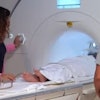"Current methods of patient dosimetry in diagnostic imaging are both extremely difficult and time-consuming, require large computing resources, or lack accuracy due to using data based on homogeneous materials and standard man-sized anthropomorphic models," the researchers noted in their abstract.
Daniel Sandoval, PhD, a medical physicist in the University of New Mexico Department of Radiology, is scheduled to discuss the method, which uses measurements obtained during routine physics testing of the x-ray unit, data from two-view radiographic images, and mean image grayscale values over the region of interest (ROI).
With the algorithm, formulas determine entrance and exit doses using a new dose-correction factor based on the exposure index and average grayscale value over the ROI. These measures are taken from radiographic images specific to a patient's body characteristics.
The researchers have tested the algorithm on standard and modified phantoms, and they found that calculated doses are within 6% of measured doses for anthropomorphic phantoms. Traditional calculation methods ranged from 2% to 104%, according to Sandoval and colleagues. Total deposited doses were within 17% of measured doses for anthropomorphic phantoms, while traditional methods showed differences ranging from 13% to 113%.



















